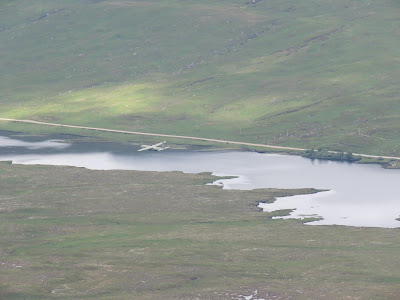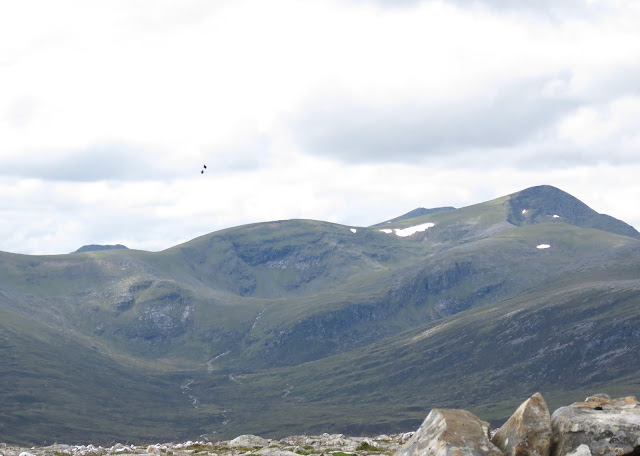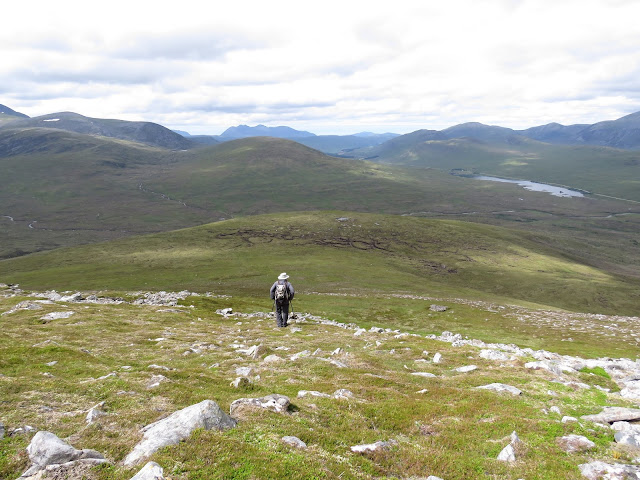Wednesday, July 08, 2020
A dry day was promised, so we planned to try once again to get up a mountain - problem was, many a hill-walker had had the same idea! The Beinn Dearg car park was busy as we passed it, with some probably having overnighted in their cars; and the Fannichs lay-by was also full. However, we had no trouble parking on the grassy verge; and all the other walkers must have gone Munro-bagging, because we had our Corbett to ourselves.
Toiling up the wet hillside we flushed a red grouse. Further on where the rock outcropped, there was mountain everlasting growing in the moss.
In a patch of cloudberry I could find only two sepals, so we were obviously too late for the flowers.
One of two military transport planes that rumbled along Loch Droma.....
.....disappearing dramatically behind the shoulder of a hill.
After the steep, usually wet slopes (which weren't too bad, considering the recent rain), we found the peat hags also drier than we'd expected, and soon we were onto the final, thrilling stage of the walk, where the vegetation suddenly becomes shorter and crisper until it's a close fitting mat between grey and lichened rocks; and as I scanned the ground for tiny plants, Greger called out that something was moving up near the skyline.
Ptarmies! I'd hoped to see ptarmigan on our first hill-walk this year, but hadn't banked on it. So far, we'd been lucky on two visits out of three to this hill.
We were both rapidly counting - five, six....in the end Greger reckoned there were eight. I thought these were immature birds, but have since realised that they are probably adults which are moving into their grey autumn plumage.
The summit cairn was surrounded by Alpine lady's mantle.
I'd thought that the military planes were going to be the most exciting airborne thing of the walk - until we saw two red admiral butterflies sparring in flight (Sgurr Mor in the background).
The butterflies landed frequently on the summit but never for long.
Two hoverflies were also difficult to snap, this one being Sericomyia lappona; the reddish scutellum can just be seen.
This is the slightly larger Sericomyia silentis - the scutellum is blackish. This is given as an aid in separating the two species, although each one is fairly distinctive anyway.
The black spots on the rock are some kind of crustose lichen.
I wandered over the stony plateau while Greger had a second cup of coffee, and spotted some of the ptarmigan again. When they stood still it was difficult to see them; I think there are four in this pic.
We set off back down. Here, we're still on delightful walking terrain, with the peat hags visible below.
The lingering snow patches on the mountains look white until I compare them with cottongrass, which seems a pure and beautiful white especially when seen against dark moorland pools - the white of a ptarmigan's feather.
Back on the track through the plantation, willow warbler, goldcrest, wren, and a family of mistle thrushes were seen. A golden ringed dragonfly flew past and a smaller one was buzzing about; it was the right size for azure hawker but it disappeared among the pines. I paused to snap some sundew plants, which at least kept still.
What a lovely day! It was a real tonic to be up there with the rocks and the moss and the views - and most of all, the ptarmigan.
















